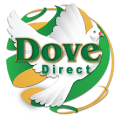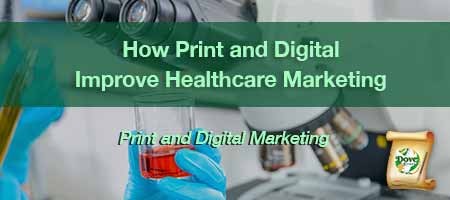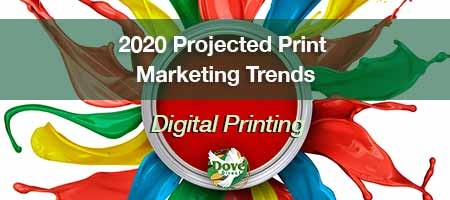How Print and Digital Improve Healthcare Marketing
Welcome to the Dove Direct Print and Marketing Blog. Today's post, "How Print and Digital Improve Healthcare Marketing," sheds light on healthcare marketing tactics and strategies that are evolving amid the pandemic. Most marketers now realize the benefits of a two-pronged print and digital strategy for various industries. Thus far, the duo strategy offers an optimal marketing ideology for vastly improving personalized content that drives higher participation and engagement numbers. However, healthcare providers looking to attract more customers are faced with a much more complicated scenario as healthcare options continue to evolve, from a federal and local perspective rapidly.
One needs to not look any further than the intricate marketing aspects brought to bear since the advent of the Affordable Care Act (ACA). The ACA brought about a new paradigm involving direct-to-consumer marketing, including the use of digital channels. That new healthcare marketing model demands better personalization, whether for selling medical services or health insurance. As a result of the ACA, healthcare premiums and insurance offerings are now more complex than ever. Furthermore, additional options that the last administration introduced have given consumers more choice but at a price. Now that there are more options on the table, it's safe to assume marketers' challenges have increased, and they must do more with less.
Quote of the Day: "It is health that is real wealth and not pieces of gold and silver." – Mahatma Gandhi
Healthcare Industry Marketing Challenges
Care delivery challenges have risen to the forefront for the healthcare industry in a consumer-centric environment. This is especially true in the wake of new medical technologies and treatments brought to bear due to the pandemic. In addition, the healthcare industry remains under tremendous pressure to manage pandemic-related illnesses while managing diseases, emergencies, elective events, along with ongoing research, discovery, and innovations. These occurrences are simultaneously afoot, necessitating continual up-to-date communications for all customers, stakeholders, and prospects.
We are all aware that there are various tactics and strategies available for marketing and advertising. That said, it's essential to keep in mind that many medical concerns and insurance providers are looking to attract new customers with their offerings. Whether solo private practices, hospitals, urgent care centers, specialists, and other medical and insurance providers, all entities must manage limited marketing dollars to achieve effective targeting results.
Print Marketing
Most marketers and brands are aware that print marketing is on the upswing. They may also be mindful that print uplifts digital response and engagement rates. In this context, print marketing includes newspaper advertising, magazines, direct mail marketing, direct-to-consumer, circulars, inserts, so on and so forth. Healthcare marketers can expand their reach when using a broader marketing mix for marketing messages. It is also critical to understand that these mediums continue to market their offerings to every household, zip code, region, city, and multiple geographical zones. Healthcare providers can reach demographically sensitive targets by placing print collateral in periodicals, specialty magazines, and local newspapers. Digital printing is a marketing medium that excels at targeting specific demographics. This marketing form can contain content meant to influence or convert a specialist, a medical facility, or something as bane as scheduling appointments.
Further, print marketing also makes a case for delivering documented changes in healthcare procedures, treatments, insurance offerings, and any healthcare community changes. Now that print is digital, technological advancements allow one to create content for a single person, group, or region, depending on what is necessary. In this case, variable data printing, aka variable digital printing, or VDP, enables you to target the recipient with various attributes.
Digital Channels
The digital channels are the go-to default marketing platforms that provide quick access and tracking. The healthcare industry has and will continue to take advantage of the online universe. Due to the pandemic, more online traffic has emerged, and as a result of folks sheltering in place, online marketing initiatives have a primarily captive audience.
Simultaneously, due to the onslaught of internet traffic, the scroll effect is on full blast, meaning that once an ad is on a digital platform such as social media, the odds are high that a good number of targets will miss the ad. Therefore, marketers would need to consider spending more dollars to ensure that those targets see the ad.
If you need a sure thing, then marketers should engage the one-two slam dunk. That is to say, print and digital. When marketers opt to lead with direct mail marketing, they can almost certainly push folks to a digital destination. The lift is exponential in that direct mail recipients will see and read the direct mail piece and then follow the call-to-action link to the digital channel, thus increasing engagement and response rates.
Print and Digital Solutions
Interestingly, a print and digital marketing strategy will allow for new solutions that support both mediums working hand-in-hand. For example, a major health care provider or insurance company has to manage data from various entities and states every month. A commercial print provider can allow for the automatic transfer of information with a customized data management solution. After cleansing and formatting, the collateral can be digitally printed, allowing for individual customization in terms of name, colors, textures, photos, and other features. A solutions provider can also provide automatic mail sort and delivery, leading to shorter turnaround times, more significant savings, and other resource-saving options.
Mixing print and digital is a slam dunk. However, we also contend that video is another heavy hitter. YouTube, Vimeo, and other platforms such as Facebook and Instagram, have video upload capability. These platforms allow you to build your brand and invite a following by adding a profile and using the channel to market and advertise your brand.
The YouTube platform is also perfect for industries that need to deliver complex information making it an ideal healthcare marketing tool. Lastly, keep in mind that print collateral and social media channels, when used together, can push viewers and direct mail recipients to YouTube as well. The more eyeballs to view the slam dunk, the better!
The Net-Net
Healthcare is a highly complex industry that can confuse people as plans change, new treatments become available, and new procedures move to the forefront. Clearly, during a pandemic, the complexity is even greater. When healthcare providers invest in print and digital, the odds are that targeted recipients will read the messages, and the desired response will occur. Thanks for reading "How Print and Digital Improve Healthcare Marketing!"
Let's have a conversation about integrated business solutions and how they can help grow your business, change behavior, and improve the customer experience.
Let us show you how to improve your document processes to optimize your workflow, reduce your costs, and maximize your organization's printing, letter shop, and mailing capabilities.
Dove Direct has an official USPS certified bureau located within our offices to save you time and money. We can even create a demo file for you. For more information, call Carla Eubanks at 404-629-0122 or email Carla at This email address is being protected from spambots. You need JavaScript enabled to view it..
Dove Direct, your Atlanta based print and mail solutions provider, offers organizations end-to-end data, printing, and mailing solutions:
- Data Management
- Variable Digital/Data Printing
- LetterShop and Fulfillment
- Digital Mail Scanning Services
- HIPAA Compliant
- Fully Automated MLOCR Presort Bureau
- Marketing and Production Management Support
- Secure Data Life Cycle Management
If you don't want to wait, you can reach Dove Direct today by calling 404-629-0122 or use the Contact Form for Dove Direct.





